Top 10 Things the Wireless Industry Doesn’t Tell You about Small Cells
By Ken Schmidt, Omar Masry, and Rick Edwards
Are you a homeowner who’s recently received a notice indicating that a new small cell antenna is going to be erected on or near your property? Or a lawmaker who has received one of the industry’s new opinion papers about small cell antenna regulations? Or an FCC Commissioner who is considering small cell rule-making? Before you start citing from or buying into the pretty pictures and bright-eyed economic projections in the opinion papers below, you should know that these industry-commissioned studies do not tell the whole story:
1. CTIA – Enabling the Wireless Networks of Tomorrow
2. CTIA – How 5G Can Help Municipalities Become Vibrant Smart Cities
2. WIA – Small Cells on Pole Facilities
What’s wrong with them, you ask? Plenty. Here are the top 10 things the wireless industry doesn’t tell you about small cell antennas:
#1: Despite the wireless industry’s calls for collocation using shared infrastructure, in practice, carriers apply for individual small cells instead of shared infrastructure like DAS.
Small cells are standalone individual cells that can be installed separately. They’re like miniature cell towers but without the tower. Like towers, a small cell requires both an antenna and equipment. Unlike towers though, the wireless industry likes to place the transmission equipment on the utility or other support structures. In effect, this means that the installation of small cells must either increase the visual blight of the pole or increase the diameter of the pole if the equipment is put inside.
Distributed Antenna Systems, in contrast, typically require less substantial infrastructure attached to each pole and can be more easily made to resemble street lights and signs (like the examples in #2). Common equipment can be placed within a centralized hub conveniently located underground or outside of view. Whereas small cells are single user installations, carriers can share DAS nodes. Multiple wireless service providers can share a DAS node, and multiple frequency bands (Carriers) can be facilitated on each node. This reduces the total number of sites needed and makes each site more attractive because most of the transmission equipment sits in a shared offsite DAS hub.
Given the benefits of DAS, you might wonder why the industry would prefer to build small cells instead of a constructing a DAS? There are 5 reasons – some of which are legitimately problematic for wireless carriers and some of which just require increased investment or time but aren’t beneficial to the bottom line.
Reason 1: Each wireless provider has different objectives and may not need the same locations.
Reason 2: Each wireless provider has different deployment times and requiring DAS may force one carrier to wait if others are not ready.
Reason 3: DAS systems cost more because they’re designed for the requirements of the most advanced user. So if carrier A needs feature X, even if carrier B doesn’t, then the system will include feature X.
Reason 4: DAS systems require a concentrated, coordinated effort and someone to lead it.
Reason 5: Small cells are easier to deploy. DAS applications are reviewed in total – meaning that an objection to any part of the DAS application holds up the entire request.
The result: Providers submit applications for small cells even in downtown, urban core areas where DAS makes more sense. In some cases, providers apply for permits on adjacent poles where it’s obvious that a DAS system would reduce visual clutter. Or even submit for new poles adjacent to other light/utility poles of similar height to avoid paying the rate schedules published by municipalities.
The map below shows the actual number of small cell application locations within the City of Houston by four different wireless entities. In a dense urban area like this – why not propose DAS nodes that all entities can share and decrease the number and impact of these facilities on the community?

The wireless industry needs to actually collocate rather than just talk about collocation. Furthermore, the FCC and cities themselves should mandate collocation when multi-carrier small cells are technologically feasible.
#2. The wireless industry associations want standardized federal, state, and local rules but don’t even standardize themselves.
The wireless industry demands standardization of state and local government laws related to the erection of small cells. Their opinion papers suggest that without standardization, wireless applicants will be hit with a patchwork of wireless siting regulations. So they’re putting forth a multi-pronged approach:
1. Distributing Industry-Friendly Sample Ordinances
2. Lobbying Heavily at State Level (see ALEC)
3. Submitting a Petition for Relief to the FCC (see Mobilitie)
4. Lobbying Heavily at the Federal Level
The wireless industry alleges — without providing any quantitative analysis — that most municipalities are applying costly, antiquated macrocell regulations to small cell applications. While many smaller municipalities do not have small cell policies in place at this time, that is because the wireless carriers aren’t building many small cells in smaller towns and villages. But many larger municipalities (and those where 90% of small cell deployment are occurring) have begun to implement small cell regulations or will do shortly.
At the same time, the wireless industry’s applicants can’t even submit consistent small cell applications to their municipalities. It’s blatantly hypocritical. For example, some cities report receiving location maps showing new small cells in the middle of ponds or on footbridges or in areas that are under another city or county’s jurisdiction. Some applicants are not even submitting site-specific applications – instead submitting the same drawing over and over. If the wireless industry believes that standardizing the permitting process is necessary, they should be willing to standardize their own small cell antenna configurations and requests as well. All applications should provide for and include the same information so that the municipality does not have to ask multiple times for the applicant to complete the basic information. Every application should include a structural analysis wet-stamped by a state licensed engineer demonstrating that the new pole or existing pole is structurally sufficient for the current loading. Plans should include where power is coming from and how power will be metered, or better yet be subject to an unmetered wireless rate or utilize wireless smart metering
The WIA and CTIA should encourage standardized applications and requirements among their member constituents. But we believe their approach should not just consist of lobbying states, the FCC, and local governments. These organizations should work towards drafting common application requirements and best practices for their constituent members. They should then discipline or reprimand those members that do not follow such practices. Most importantly, wireless industry associations should focus on assisting member entities in developing and using shared infrastructure.
#3. What the industry installs looks vastly different than what they say is possible.
You may remember this article that went viral where Buzzfeed compared the fast food company photos of their food vs. what the consumer actually received.

Similarly, the wireless industry’s glossy pictures show an idealized implementation that is far different from reality. Their reports showcase integrated poles with small cells contained within or Distributed Antenna Systems (DAS) nodes with an off-site equipment hub. These appear slim and attractive (relatively speaking). However, when these same wireless carriers or small cell companies submit the actual drawings and applications, the installations do not look anything like those pretty glossy pictures. Or, after they install the attractive poles, they bloat the view with additional equipment, creating a visual blight.
For example, below are photos promoted in the WIA Small Cell document. (Note these pictures are DAS nodes- not Small Cells – see #4 below)
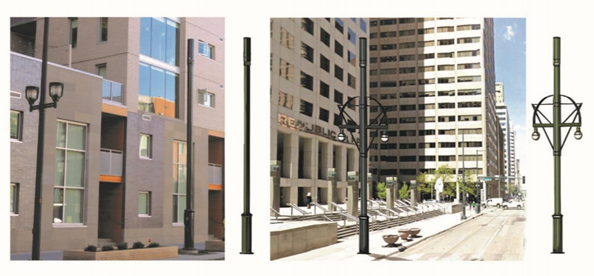
Compare those to photos of actual small cell installations. They are nothing like the photos shown in wireless industry propaganda.
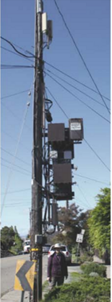
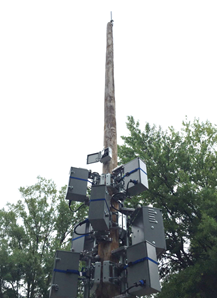
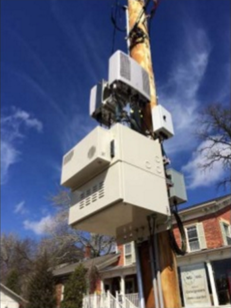
The reason for this is twofold: First, the industry likes to show pretty photos of DAS nodes because they are actual possibilities, even though the wireless carriers and tower companies are increasingly abandoning them. Wireless carriers are instead building small cells which usually have more equipment on the pole than DAS’s central hub. Second, in many cases, the applicant omit to mention a part of the equipment that’s to be mounted near or on the pole either because they’re rushed or because they don’t want to answer objections. The municipality is left holding the bag – inspecting each constructed small cell in order to confirm whether the applicant exceeded what they were authorized to install. Don’t believe this actually happens? Look below to see what the industry submitted as a photo simulation versus what was eventually installed.
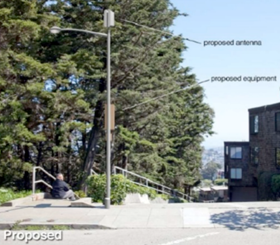
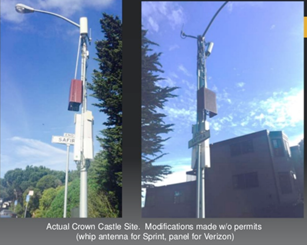
#4. Once a site is erected, they can go back and increase its size ad nauseam provided that the changes do not exceed federal standards.
Once a small cell or DAS node is attached to a pole, the wireless carriers have the right under Section 6409(a) of the Middle-Class Tax Relief and Job Creation Act to expand their equipment. In other words, once a site is built, municipalities have little power to restrict further expansions of the pole’s small cell antenna equipment if the applicants stay within the limits of 6409(a). Moreover, wireless companies can request to expand an unlimited number of times. So even if a small cell starts off looking small and svelte – it could be expanded in size immediately without the municipality being able to stop the expansion. And this can happen over and over again.
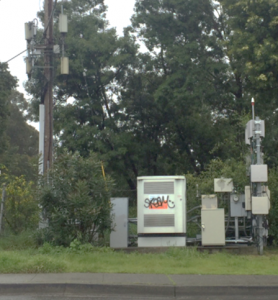
#5: The industry claims that wireless development will not occur without major policy changes. But in fact, wireless development has occurred and will continue to occur even without those changes.
Historically, the industry has made the same argument over and over again: that they will not be able to deploy infrastructure if wireless siting laws aren’t loosened. They suggest that most any regulation that slows down wireless deployment limits technological advancement. The industry puts out derisive blacklists of cities and counties that one or more wireless company believes make it difficult or expensive to deploy wireless infrastructure. They label these cities as technologically backward and lobby decision makers to convince them that their city will not grow with such technological restrictions. For example, see this quote from Gary Jabara of Mobilitie about municipalities or counties who aren’t receptive to Mobilitie’s proposals to erect 120′ mini-macro small cells in their city or county.

Nonetheless, even in expensive markets with incriminating reviews like the one above, small cell deployment still occurs. Wireless companies still build towers or even find private locations for rooftop cell sites. A quick examination of Verizon or AT&T’s coverage map will show very few holes in urban or suburban areas.
Furthermore, in most states (35 or more) wireless companies have access to utility poles which are subject to pole attachment rates prescribed by the federal government. These pole access rates are fairly reasonable; they are typically less than $500/year per pole. However, working with the utilities can be time-consuming, which is why the wireless industry is pushing for easier access to municipal poles. Isn’t it odd that wireless carriers claim to be utilities but aren’t actually using utility poles?
Even in markets like Baltimore, MD where the small cell rates are somewhat high compared to other US cities, Baltimore is still receiving small cell applications at a pace comparable to communities with closer-to-average rental rates. In other words, while the industry claims that higher rates impede technological advancement for a city, the reality is that wireless carriers still build small cell sites and many of them. While small cell deployment would likely happen quicker with revisions to regulation and cheaper access to municipal structures, make no doubt about it, the development would occur either way.
#6: The industry labels any request for cost reimbursement or rents by a municipality as a “money grab” all while the industry itself is generating $60 billion in profit per quarter.
We participated in a meeting between one city and members of one of the national wireless trade groups. The trade group decried the city’s rent requests for access to taxpayer-funded infrastructure as a “money grab.” Meanwhile, each of the wireless carriers has generated 20% profit margins or better in recent years – with at least one generating margins over 40%. The Big 4 wireless carriers alone are generating nearly $60 billion a year or more in EBITDA margin while the wireless industry combined generated $85 billion.

To argue that municipalities are money grabbing by charging a reasonable price for access to publicly-funded infrastructure by for-profit entities is disingenuous at best.
If one assumes the industry is constructing 20,000 new small cell antennas a year, even if each pole fee was $3,000/year, the wireless industry AS A WHOLE would only lose out on $60 million or less than .1% of their annual profit. Yes, you read that right,- less than 1/10th of 1 percent of their annual profit.
To put in perspective, Verizon and AT&T alone spent half that amount on lobbying alone in 2016. (see Open Secrets for AT&T and for Verizon)
These arguments seem even more duplicitous when you see the headlines put out by the wireless industry that extol the tremendous revenue opportunities from 5G and other advancements. For example:
The Qualcomm “survey,” says the 5G future will support up to 22 Million Jobs and $12 trillion dollars of goods and services.
Cisco says 50 billion things will connect to the internet. Read this article on why the hype on the number of connected devices is overblown.
CTIA citing an Accenture analysis suggests that 5G stands to create 3 million jobs in the US while yielding investment of $275 billion and encouraging GDP growth of $500 billion.
Simply put, the industry has every right to attempt to negotiate with municipalities for cheaper access to taxpayer funded and maintained municipal poles. But if they insist on making it about money, we believe those same taxpayers and municipalities should be prepared to point out the hypocrisy in their claims.
#7: The wireless industry wants to pay less for their small cell permit applications yet still receive faster review timelines from understaffed cities and counties.
Historically, we estimate that most cities rarely received more than 50 applications for new wireless sites per year from 2000-2015. Even in the boom years of 2008-2010, cities may have received just 150 applications for new wireless facilities. Contrast that to today: we have confirmed that the City of Houston received over 700 applications in 2016 alone for small cell infrastructure.
On the one hand, the wireless industry politely (or not so politely) asks for a quick turnaround on small cell antenna applications (complaining to the FCC and state representatives when they don’t get it) but then on the other begrudges municipalities for charging fees to review the applications. For those of you not entrenched in the minutia of municipal red tape, these requests for the use of infrastructure or placement of equipment are rarely identical from one application to the next. Some companies are very good at drafting thorough and complete applications, but most are not. No matter what size the project is, the items to review in each application are the same. Each site still needs to be reviewed for structural, electrical, and physical safety.
Without standardization by the industry, these applications can’t be reviewed easily. This, in turn, increases the cost to the municipality for reviewing such applications. The industry wants the best of all worlds – to submit hundreds of applications simultaneously, have those applications reviewed quickly regardless of their quality, and pay as little as possible for the city to review them.
Some members of the wireless industry have suggested that cities do not need to review the applications thoroughly as the wireless entities already do so internally. For proof of how ineffectively self-regulation works in the wireless industry, look no further than the 2007 Malibu Canyon fire which was caused by utility poles that were physically overloaded with telecommunication company antennas and equipment. Apart from safety concerns, the proliferation of poorly designed small cells can also degrade historic districts and draw noise complaints from neighbors when a carrier with loud cooling fans is mounted on a pole a few feet from a bedroom window.
#8: The wireless industry extols the wide-ranging benefits of the Internet of Things (IOT), smart cities, and self-driving cars, but fails to mention that many of these benefits can be obtained using current LTE-based technologies.
First, let’s be clear that there are absolutely many wide-ranging benefits from 5G and small cell densification. Truly mobile IOT won’t happen without wireless industry investment. No other private or public entity can or will develop sufficient wireless infrastructure in the US to enable pervasive low latency communications. Without wireless industry investment, remote control of sensitive machinery or vehicles simply won’t occur. Self-driving autonomous cars will be possible but without the gains in safety and efficiency that would occur from a truly smart network of connected cars.
However, you can get the benefits of low bandwidth, non-essential IOT or smart city sensors and functions without small cells at all (or at least with fewer of them). The CTIA (Accenture) study above cites the benefits using smart meters and smart lighting. These include traffic management systems, public transportation location-based tracking, real-time public parking information, and gun-shot recognition. These are all benefits to be gained from IOT. However, neither Accenture nor the wireless industry makes any attempt to quantify or distinguish which smart city and IOT initiatives require wireless industry involvement and which don’t.
Furthermore, these studies don’t even remotely acknowledge which IOT benefits can happen on today’s LTE networks versus those that need more robust densification of sites to occur. The wireless industry leads you to believe that you need the innovations they want to sell you to get any of these advances of the future. That is inaccurate.
#9: While the wireless industry claims densification of small cells is needed to enable smart city and IOT functions, they don’t tell you that mobile video is the primary use of small cells both now and in the future.
Cisco, in its 2017 Global Mobile Data Traffic Forecast Update, indicated that video currently makes up 60% of mobile data traffic. Moreover, they forecast that three-quarters of the world’s mobile data traffic will be video by 2021. Ericsson’s own study states that mobile video traffic represents 55% of LTE/5G data traffic now, but is expected to grow to 95% (yes- 95%) of mobile data traffic by 2021.
Cisco states further that 50 billion IOT devices will be connected to the internet within 5 years. However, only 1.5 billion of these devices will have cellular connectivity. We have seen forecasts from other sources that IOT mobile data use will grow to 8% of total network mobile data use by 2021. In other words, IOT functionality only drives less than 10% of the bandwidth need for small cell densification.

This raises the question: how many small cells are necessary to enable Smart City and IOT initiatives versus how many are really needed to densify networks for the next generation of fixed wireless to home and mobile video? For further information on why mobile and fixed wireless video is so important to AT&T and Verizon, see this article on the wireless industries efforts to compete with the cable companies.
To be clear, we aren’t suggesting that mobile video or fixed wireless are inconsequential. Without the revenue generated from mobile and fixed wireless video, the wireless industry would not have the incentive to invest as much Capex in their wireless networks to enable some of the truly amazing IOT and smart city use cases – especially those that require low latency or secure and ultra-reliable communication.
We are, though, suggesting that any indication by the wireless industry that 5G and small cell densification is primarily about IOT and smart city functions is a half-truth at best. The reality is that small cells densification is more about paid consumer and commercial video than it is about IOT or smart cities.
#10. The industry is willing to push select information about small cells but not willing to respond to substantive questions from municipalities.
Before a recent meeting began between one city and 20+ representatives of wireless and tower companies, each side exchanged questions. The wireless industry provided 30-40 questions to the city, and the city provided a list of 15-20 questions to the industry. The city’s questions were fairly straightforward:
What do the wireless providers see in terms of other cities that require rental payments?
How many small cells does the industry contemplate installing in the city over the next 5 years?
What type of infrastructure/antennas does the wireless industry expect to need on the poles?
The city responded to all the industry’s questions with substantive detail. In return, only ONE company responded to the city’s questions. And most of those responses were cop-outs – claims that they couldn’t answer due to competitive concerns. CTIA/WIA provided a glossy presentation that discussed all of the overarching benefits of IOT and 5G, but failed, for the most part, to provide any substantive and direct answers to the questions posed by the city itself.
At the end of the day, the wireless industry wanted to poke holes in the city’s effort, but was unwilling to answer important questions that would have helped the city review and revise its own policy.
How can any city reasonably be expected to plan and prepare adequately for small cell infrastructure when the wireless industry continues to provide limited substantive information?
So Where Does this Leave Us?
Municipalities need to realize that wireless investment in small cells should be encouraged and reasonably managed and that doing so requires investment in staff and resources. They can no longer put their heads in the sand because it isn’t a question of if, but of when and of how many small cells are coming. Reactionary policies and moratoriums almost always rushed and neither encourage thoughtful technological expansion nor protect the constituents.
Wireless carriers, tower companies, and industry associations need to provide better substantive guidance to their member constituents including model applications and construction/design criteria. They should truly encourage shared infrastructure use especially in dense areas where multiple providers want access to existing poles. These groups and companies should also be more forthright in their marketing materials and in answering legitimate questions and concerns by public entities.
We, as advisors to landowners and municipalities, will continue to help educate the public about the small cell leases and policies. Most landowners and municipalities are underrepresented and ill-informed when it comes to responding to the wireless industry’s requests and/or demands. We hope that by highlighting the top 10 things the industry doesn’t tell you about small cells, that you can better decide how to accomplish your goals. That small cell deployment will not be allowed to grow unchecked and unabated by an uninformed populace.












9 thoughts on “Top 10 Things the Wireless Industry Doesn’t Tell You about Small Cells”
REBUTTAL to 10 Things the Wireless Industry Doesn’t Tell You
Your article, though no doubt well meaning, is more misleading than the wireless industry.
1. Collocation
Wireless carriers build DAS and small cell sites. You chastise wireless carriers for deploying small cells, yet explain five reasons why you understand that. None of what you understand recognizes that DAS is best suited where one property owner controls a large venue like an office building, a stadium, or a campus and can coordinate the development of the system to serve the property. Unlike local government, wireless carriers operate in a competitive environment. It shouldn’t be any wonder that small cells will permeate every neighborhood in America like other essential services including water, power, sewers, and roads. Local governments have a great opportunity in the public rights of way to facilitate the growth of wireless infrastructure in America.
2. Standardization
By asking the industry to standardize its applications you are, in effect, saying impose a federal standard on all jurisdictions. The assertion that wireless carriers should submit consistent applications to jurisdictions (none of which have the same application process) is mere smoke screen. There is no one application format on which all jurisdictions will agree. It would be much easier for the wireless industry to comply with a single standard application for small cells. Given the widespread use of wireless services and their extensive impact on the function of our society, why shouldn’t the standard installation permit application of small cells be as routine as a connection to water service, ordering power service, or subscribing to cable television. If it wasn’t for the FCC standardizing restrictions placed by local jurisdictions on over-the-air satellite receivers millions would still not have access to satellite broadcasted television today.
It is true that no two wireless facility installations are the same, reflecting how service to each community is unique. Trying to fit every installation into the same box may serve the uniformed but it’s no way to design wireless service to each nook and cranny of a city or a nation. The standard that needs to be determined is what size of antenna and other equipment constitutes a micro or small cell facility, since they require so much less volume than a macro cell facility. It is unreasonable to regulate them the same. The aim of legislation being proposed in many states is already in the Nationwide Programmatic Agreement for Collocation of Wireless Antennas (NPA) between the Advisory Council on Historic Preservation, the National Conference of State Historic Preservation Officers, and the FCC (as amended, 8/3/2016). How can you argue with the historic community?
3. Photo-simulation
Local jurisdictions are able to enforce established regulations and the conditions under which a permit is approved. It’s the local jurisdiction’s responsibility to call out bad actors that don’t play by the rules and deserve to be fined for violating the stipulations of a permit approval. How do you expect an industry association to do that? Aren’t you just trying to pass the buck? Blaming the whole wireless industry for the acts of one or a few is a gross mis-characterization and an abdication of a jurisdiction’s authority.
4. Collocations on Existing Wireless Facilities
Section 6409(a) of the Middle-Class Tax and Job Creation Act of 2012 was a very fair way to end the micro-management of permit applications for collocations on existing wireless facility structures, just as was the over-the-air reception devices rule was in 1996 for millions of Americans desiring access to satellite television services.
If collocation reduces the effect that would result from installation of a new structure, why debate over collocations for small antenna systems. The amended NPA has already established the parameter of three cubic feet for an individual antenna, six cubic feet cumulatively for small antennas on a structure, and twenty-one to thirty-five cubic feet for associated equipment, depending on the type of structure, the location, and if the structure accommodates three providers or less. The Section 106 process provides the opportunity for input from interested parties on a proactive basis requiring dissidents to make notice and prove their case on a timeline instead of being allowed to craft delays.
5. Yes, wireless facility development will occur but without a change in perception and new streamlined processes for the new micro and small cell facilities that qualify, application processing productivity of municipal planning departments will be affected. Do planning department put so much effort into reviewing every new wireless parking meter or water meter that gets installed. Do all new wireless vending machines require such scrutiny? A local permitting log jam for small cells will turn into a barricade against market demand for high speed quality wireless services not acceptable to the society at large.
6. A lot more investment goes into the development of a new wireless facility and operation of a national network than you suggest. Do you really want to insinuate that permit fees are the only cost factor to consider? Wireless facility developers just want fair and equal rates and not to singled out because someone like you thinks they make too much money.
7. It’s just a fact of life that in areas where customer demand exists and macro cell sites aren’t feasibility it takes more micro or small cell locations to service the neighborhood. That’s the technological trade-off. By limiting the size of a qualified micro or small cells consistent with the minimal amount of processing time that should be necessary, it should be feasible to reduce the cost to the jurisdiction to process the installation permit, if not for micro-management. Many jurisdictions will welcome the opportunity to consider the smaller lesser impact small cells administratively or as permitted uses whether in the public right of way or not.
8. On one hand, you clearly acknowledge that the maximum benefits of 5G, the internet of things, and self-driving vehicles won’t happen without big wireless industry investment while in the same breath question the need for advancements in technology and the role wireless technology will play in these innovations. These statements are irrelevant.
9. Much larger amounts of telecommunications capacity are necessary to communicate mobile video signals than a voice signal or an email. Without dramatic increases in wireless system capacity across the board, the demand for growth of mobile video services could preclude the growth demand of other services that require much less bandwidth. Wireless carriers face challenges in satisfying the needs of all their customers. It just so happens that mobile video is bandwidth intensive.
10. While you accuse the wireless industry of providing select information, your arguments take pot shots without solid support. OK, some companies can’t be trusted. You are encouraged to treat those businesses appropriately. The bottom line is that the wireless business has more than enough to do to keep up with the current growth in customer demand that has no limits in the foreseeable future. You’d like the wireless industry to be able to accurately project how many applications it will make in next five years in an environment that requires full attention in the present. To answer your question, the projection is millions. So now, what you do want to do with that knowledge? The point it is crucial to be part of the solution not the problem.
Thanks for the effort here.
I think you’re sort of missing though, when you pit DAS against small cells. It’s not one or the other. The real debate is macro cells vs small cells. Not DAS. In fact most DAS architectures now can accept a small cell feed, or a BTS. So, they don’t care.
The main problem with DAS today is the business model. In your essay, you almost attack the service providers for wanting to make money, vs spend it with municipalities, tower companies, and the like. The problem you have here is, ANYONE who has worked with those companies has done so (1) because they had no choice and/or (2) it was very painful.
The tower and turf companies created the incentives that spawned the small cell industry…so you have yourselves to blame.
I am looking for an opportunity to start an installation company to install equipment in cities wanting 5G. I would like to do this is a straightforward way that is both good for the city, citizens and the 5G companies. How can I get started to be ready for the big push ?
The cities won’t be involved much in 5G other than on the regulatory side. The opportunity is providing services to the wireless industry. The key is fiber and electrical engineering. Both are definitely needed for installation of the equipment.
I’ve been hearing both ‘yes’ and ‘no’ that living with 5G technology and its impending proliferation is safe for humans and should have no long term health repercussions. Do you know of any studies that do include the pulsing and conclude that 5G is safe? I work in rural community development.
I don’t know that there are any studies that specifically address 5G- but any of the studies that address near field radio frequency emissions should be applicable.
I'm somewhat surprised, but as you have photos from Verizon's install in Denver, I actually went and saw some of these poles.. They actually do match what was proposed.. I've still not yet been to downtown to see the ones on the 16th Street Mall, and other areas with the triangular-style-streetlights, but the standalone poles are within visual congruency.
https://ibb.co/kWgcgo
https://ibb.co/g96A1o
https://ibb.co/guRXE8
https://ibb.co/nNnHgo
Compare these to a legacy AT&T "flagpole" https://ibb.co/gDyeu8
I thought that it was interesting when you said that one thing to consider when you are looking to hire wireless construction is that not every company provided service in all areas. I have been thinking about hiring wireless construction but I have been worried that I wouldn’t be able to attain this in the location that I am in. I would be sure to consider comparing different companies to find service that will benefit me most so that the service will reach the location that I am in.
Need help in a contract for small cell facility